|
|

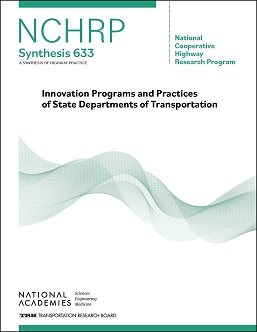 Innovation Programs and Practices of State Departments of Transportation
5/24/2024 7:00:05 PM
Innovation Programs and Practices of State Departments of Transportation
5/24/2024 7:00:05 PM
The focus on innovation across state departments of transportation (DOTs) continues to grow and strengthen. Unlike research activities, which have established programs and processes, innovation programs are relatively new. DOTs are focusing more directly on innovation, including that related to internal organizational excellence and external program and project development and delivery. NCHRP Synthesis 633: Innovation Programs and Practices of State Departments of Transportation , from TRB's National Coo...
 Integrating Performance-Based Planning into Long-Range Transportation Plans and STIPs
5/24/2024 6:00:46 PM
Integrating Performance-Based Planning into Long-Range Transportation Plans and STIPs
5/24/2024 6:00:46 PM
State departments of transportation (DOTs) must develop long-range transportation plans (LRTPs) and State Transportation Improvement Programs (STIPs) as key products of the transportation planning process. DOTs have a long history of developing these documents through many cycles of planning. NCHRP Synthesis 631: Integrating Performance-Based Planning into Long-Range Transportation Plans and STIPs , from TRB's National Cooperative Highway Research Program, documents current practices of state DOTs relate...
 Ancillary Asset Data Stewardship and Models
5/22/2024 6:00:09 PM
Ancillary Asset Data Stewardship and Models
5/22/2024 6:00:09 PM
Some state departments of transportation (DOTs) have begun to track data pertaining to ancillary assets (that is, assets other than pavements and bridges) in their Transportation Asset Management Plans. However, most DOTs do not track this information, even though they inventory and manage many of these ancillary assets. NCHRP Synthesis 628: Ancillary Asset Data Stewardship and Models , from TRB's National Cooperative Highway Research Program, documents state DOT practices related to data models and data...
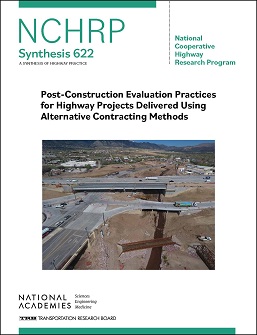 Post-Construction Evaluation Practices for Highway Projects Delivered Using Alternative Contracting Methods
5/16/2024 3:00:39 PM
Post-Construction Evaluation Practices for Highway Projects Delivered Using Alternative Contracting Methods
5/16/2024 3:00:39 PM
Alternative contracting methods (ACMs) capture the delivery methods that are not design-bid-build (D-B-B), low bid, or traditional federal aid. Common ACMs used by state departments of transportation (DOTs) include design-build (D-B), construction manager/general contractor (CM/GC), progressive design-build (P-D-B), public-private partnerships (P3), and indefinite delivery/indefinite quantity (IDIQ), which is also called job order contracting. NCHRP Synthesis 622: Post-Construction Evaluation Practices f...
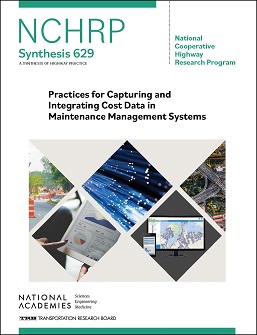 Practices for Capturing and Integrating Cost Data in Maintenance Management Systems
5/10/2024 4:00:17 PM
Practices for Capturing and Integrating Cost Data in Maintenance Management Systems
5/10/2024 4:00:17 PM
State departments of transportation (DOTs) face considerable challenges in implementing, enhancing, or replacing their existing maintenance management systems (MMSs). These processes are not only expensive and time-consuming but also involve considerable risk, because these systems have usually been in place for many years. NCHRP Synthesis 629: Practices for Capturing and Integrating Cost Data in Maintenance Management Systems , from TRB's National Cooperative Highway Research Program, documents current ...
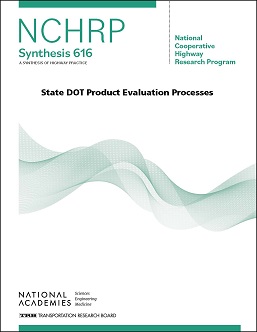 State DOT Product Evaluation Processes
5/9/2024 1:00:57 PM
State DOT Product Evaluation Processes
5/9/2024 1:00:57 PM
The construction, maintenance, and operation of transportation infrastructure requires immense amounts of products and materials. New products, materials, engineered systems, and innovative technologies are presented to state departments of transportation (DOTs) by suppliers and manufacturers, as well as sometimes by contractors and internal DOT staff. NCHRP Synthesis 616: State DOT Product Evaluation Processes , from TRB's National Cooperative Highway Research Program, documents current state DOT practi...
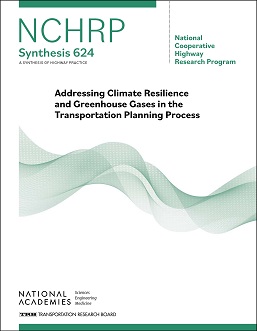 Addressing Climate Resilience and Greenhouse Gases in the Transportation Planning Process
4/30/2024 6:00:00 PM
Addressing Climate Resilience and Greenhouse Gases in the Transportation Planning Process
4/30/2024 6:00:00 PM
Many state departments of transportation (DOTs) are undergoing organizational changes to address climate change. Changes range from hiring additional staff to creating new offices within the organizational structure of the agency. State requirements in the form of legislation, executive orders, and climate action plans are primary drivers for state DOT involvement with climate change. NCHRP Synthesis 624: Addressing Climate Resilience and Greenhouse Gases in the Transportation Planning Process , from TRB...
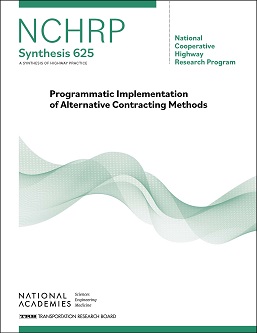 Programmatic Implementation of Alternative Contracting Methods
4/17/2024 6:00:30 PM
Programmatic Implementation of Alternative Contracting Methods
4/17/2024 6:00:30 PM
Alternative contracting methods (ACMs), including design-build, construction manager/general contractor, and public-private partnerships have added a wide range of options for state departments of transportation (DOTs) to consider when delivering projects. NCHRP Synthesis 625: Programmatic Implementation of Alternative Contracting Methods , from TRB's National Cooperative Highway Research Program, documents state DOT practices of programmatic approaches to ACMs.
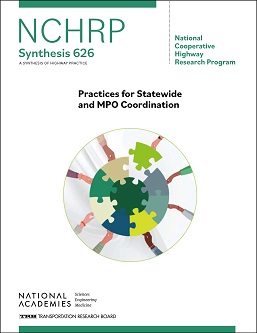 Practices for Statewide and MPO Coordination
4/17/2024 6:00:29 PM
Practices for Statewide and MPO Coordination
4/17/2024 6:00:29 PM
State departments of transportation (DOTs) are required by federal law to coordinate transportation planning and programming processes with metropolitan planning organizations (MPOs) in the state. However, state DOTs and MPOs have varying coordination practices depending on their specific contexts. NCHRP Synthesis 626: Practices for Statewide and MPO Coordination , from TRB's National Cooperative Highway Research Program, documents current DOT strategies and practices to facilitate coordination between s...
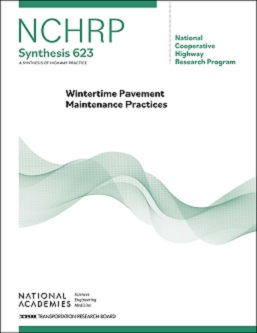 Wintertime Pavement Maintenance Practices
4/4/2024 7:00:30 PM
Wintertime Pavement Maintenance Practices
4/4/2024 7:00:30 PM
State transportation agencies have many tools available with which to maintain pavements proactively. These include tools such as pavement management systems to track roadway conditions and life cycle cost analysis tools. NCHRP Synthesis 623: Wintertime Pavement Maintenance Practices , from TRB's National Cooperative Highway Research Program, documents the current state DOT practices for the reactive pavement maintenance performed during the winter months when flexible and rigid pavements must be repaire...
|
|
|